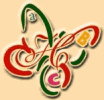'FINE HUNGARIAN BOOKS'
ONE HUNDRED YEARS FROM THE HISTORY OF HUNGARIAN BOOK PRINTING ART
(1880-1980)
 Historical
overview
Historical
overview
he revival of Hungarian book printing can be dated back to the 1880s, when the strengthening middle classes started to demand not only books for the masses but also 'fine' books as well. At the same time, a growing sector of Hungarians grew interested in books of good paper quality and large format that were produced by modernised press techniques.
These prints, gilded publications and albums, normally covered in leather, linen or silk binding, were characteristic representatives of Historicism. The pages of these books had been illustrated by famous artists, (Munkácsy, Feszty, Zichy, Benczur, Stetka) distinguished members of famous art academies and workshops such as Munich and Paris. Exemples of these books include The Pictorial History of the Austrian-Hungarian Monarchy, Petőfi Album, The Album of the Martyrs of Arad, Album of Poets etc.
As to their decoration, the publications of fashionable contemporary writers were almost as good as some fine arts pieces such as 'The Collected Poems of Sándor Petőfi', published in 1900; the Vörösmarty Album or the 1898 edition of Sándor Bródy's 'Silver Goat'. The names of Mihály Zichy, Árpád Basch and János Vaszary should, be picked out as the best illustrators of these albums.
The independent Hungarian genre of artistic book printing was brought into life with the mediation of several Hungarian artists (Zichy, Rippl-Rónai, Divéky, Falus, Basch, Pogány), who learnt and worked in England, France and Germany and had reflected the inspiration of those celebrated art journals (Revue Blanche, The Studio, Jugend, Ver Sacrum, etc.) that had been circulating in the country. Amongst the representatives of Hungarian Jugendstil one should emphasise the names of Rippl-Rónai, Vaszary and Gulácsy.
Jugendstil appears in the ornaments used by Hungarian printing since the end of the 1890s. The representatives of this process of book printing revival, following the English example, aspired to accomplish the unity of styles between text, pictures, characters, head- and footnotes, closing illustrations and that a harmony of inner and cover pages. The usage of decorative and stylised plant motives spread throughout Hungary shortly after the turn of the 1890s under the strong influence of folk arts. Besides architectural design, there were attempts to bring the Hungarian Jugendstil into life through graphics, too (Elek Falus, Lajos Kozma, Károly Kós and the artist group of Gödöllő).
Graphic illustration, thus became a mediator of modern art as it had been connected to and simultaneously inspired by literature which played a major role in Hungarian artistic circles.
The exhibition
In our exhibition we provide an independently unique place for the presentation of the periodical called 'West' (Nyugat), which was first published in 1908, and for the books that had been published through its editorial board. They include works of Elek Falus, Anna Lesznai and Arnold Gara. We give a taste of illustrated children's literature and of literature that inspired graphical albums from the period between 1900 and 1925 as far as the limits of the pavilion make it possible.
Apart from the books placed in the glass-cases, the illustrations and reproductions on the boards we also show pieces from the poster art of these hundred years. The exhibition follows a chronological order and is divided into eras by tableaux with 4 x 12 pictures of famous writers and poets.
In the middle of the 1910s, the Kner Press founded in Gyoma and the Tevan Press and Publisher founded in Békéscsaba introduced a formal language that accomplished unprecedented unity in the sense of form, content and originality in its typography. The volumes from the Guild of Fine Arts of Transylvania have achieved public acknowledgement by applying elements of folk ornaments and architectural drawings and by making designs of bindings and covers on a highly artistic level.
Besides Jugendstil, which turned empty in the area of the applied graphics, some representatives of the Hungarian Activism (Fauvism, Cubism, Expressionism, Constructivism), under the leadership of Lajos Kassák, who kept close contacts with the groups of Avant-garde literature and arts in Berlin, closed up the ranks with the forefront of European arts (Kassák, Bortnyik, Uitz, Mattis Teutsch).
The new generation of graphical artists, growing up between 1920 and 1930, created brilliant book illustrations using the woodcutting technique (Pál Molnár C., Kálmán Gáborjáni Szabó, György Budai).
The coppercuts of István Szőnyi and the Indian ink drawings of Lajos Szalay already lead us to the post-war period. From the end of the 30's, until the beginning of the 50's the continuity of the Hungarian art of book is guaranteed by such names as Béla Kádár, Dezső Kornis, Lajos Szalay, Imre Ámos, Gyula Heinz and Endre Bálint.
Chosen from the politically-ideologically predetermined book harvest of the 1950's and 60's we exhibit artworks of some famous typographers, significant artists of the book workshops founded in the mid-60's and from the golden age of contemporary illustrative art (János Kiss, Gyula Feledy, Tibor Csernus, Béla Kondor, László Lakner, István Tevan Engel, Ferenc Banga, Imre Szemethy, Róbert Swierkiewitz, etc.).
Finally, in honour of the world-famous and recognised Tibor Szántó who was born in 1912 and who still works today, we present some of his most well known masterpieces.
The material of the exhibition was put together using the library and art collection of the Petőfi Museum of Literature and the graphical collection of the Hungarian National Gallery.
 |
Frankfurt '99
Non-profit Organisation,
Budapest 1054 Báthori u. 10. Fax: +(36) 1 269 20 53 E-mail: frankfurt_99.kht@mail.matav.hu |
|